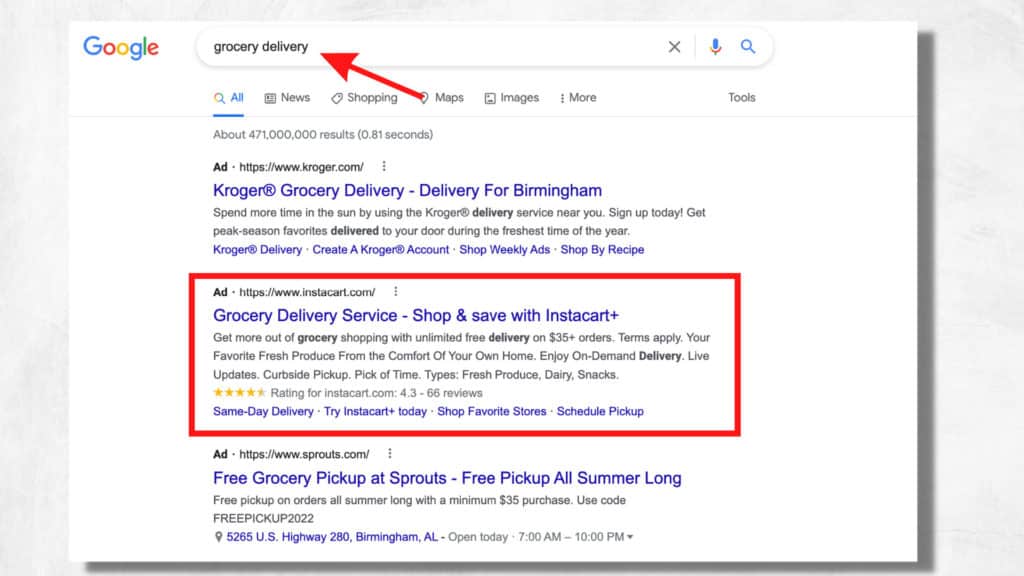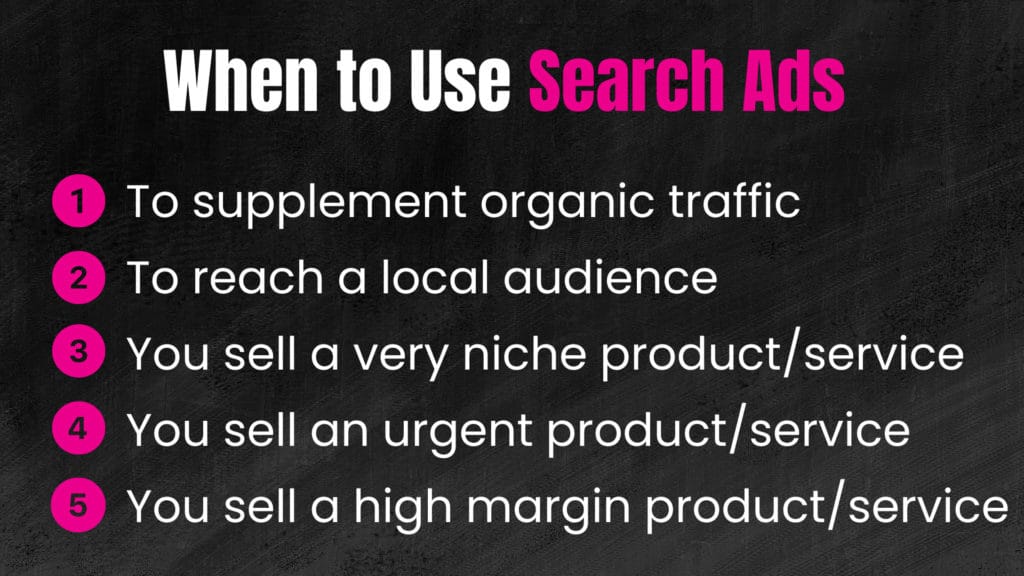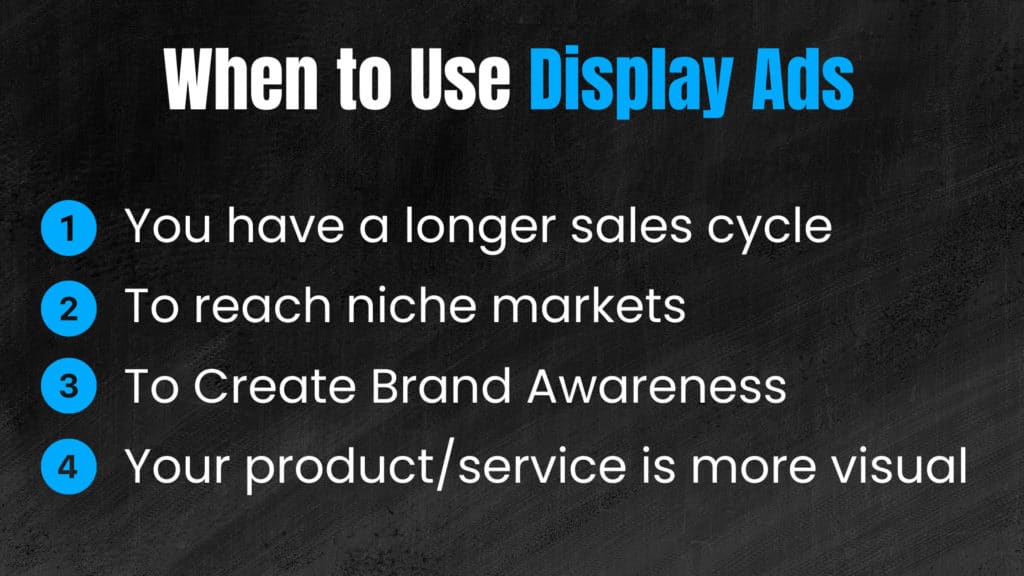Advertisers spend millions of dollars every year on Google Ads for one simple reason: they work. But the next question is, which type of Google ad is better for your business? To help you avoid wasting your marketing dollars, we are going to explain the differences between Google Display Ads and Search Ads and how to determine which of these two is best for your business.
Welcome to Marketing and a Mic. We’re here to give you a variety of digital marketing tips, trends, and useful guides to help your business get results. We have so many choices when it comes to online advertising, and the decision about which is right for you really comes down to what you want to achieve with your advertising. So, let’s dive in.
SEARCH ADS
Paid Search Ads are one of the most popular forms of PPC advertising. Search Ads are the ones you see right at the top of your search results. You’ll know it because it will have the word “Ad” in bold right next to it. They are formatted just like a search result. Using an auction-based model, these ads are displayed above and below the organic search results when a user’s search terms match your ad’s keywords terms.
For example, search for “grocery delivery,” and you will see the text ad in Google’s SERP. Search Ads have three main components: a headline, a display URL, and a text description. It’s all designed to give users exactly what they are looking for with the hopes they will click through to their business.
Search ads only appear to those who are already searching for your type of product or service. Their targeting capabilities are based on keywords and location parameters. How often your search ads appear depends on the bid and Quality Score.
DISPLAY ADS
Although Display Ads originate from Google, they are very different than their counterpart. Display ads are distributed through the Google Display Network. This is a collection of over 200 million sites, apps, and videos where your Google Ads can appear.
The GDN reaches 90% of internet users worldwide – that’s a lot of eyes that could see your business. While Search ads only appear to those who are directly searching for your product or service, display ads are paid ads that are placed based on various targeting parameters.
They allow you to target through websites, social media, newsfeeds, emails, etc., across a network of over 200 million sites. You can even hand-pick website placements that fit your target audience.
GOOGLE DISPLAY ADS VS GOOGLE SEARCH ADS
There are multiple differences between Google Display Ads and Google Search Ads. The obvious one is how they appear across the internet. Search Ads only appear in Google’s SERPs and are limited to text. Display Ads have multiple design sizes and formats and can include images or video. They are not limited to SERPs and can appear across the internet
Although Display Ads originate from Google, they perform very differently from their paid search counterpart. While search ads are a form of “pull” advertising, display ads are a type of “push” advertising.
In other words, people who come across your Search Ads are already looking for your product or service. Display Ads use a different approach. They target users by audience attributes and custom intent keywords. You pick which website placements best fit your target audience and position your ad to display on those sites. The idea is that although they aren’t directly looking for your product or service, they are the type of individuals that would be interested in your brand.
Because Search Ads are designed around people already searching for your type of brand, price and click-through rate (CTR) are higher as well. Search Ads have an average CTR of 3-4%, of which a GDN is just 0.5%. That may look very minimal, but the conversion rate and average cost per click (CPC) for display ads are much lower. Search Ads average $2.41 per click compared to only $0.59 CPC for display ads.
Search Ads have a higher cost-per-click simply because it has a higher search volume and a higher competition for ad space. Putting budget and cost aside, how do you know when to use search ads vs. display ads? It all comes down to your marketing goals.
WHEN TO USE SEARCH ADS
To Supplement Organic Traffic
Since SEO uses the long game to build organic traffic to your site, some business owners may need to rely on an immediate solution to bring people directly to their business in the meantime. This makes search ads a great short-term strategy while they build their organic presence.
To Reach a Local Audience
If you offer a local service and are trying to capture a local audience, search ads are perfect. Search ads have great targeting options that allow you to focus on a specific city or region and display your ad to only people in that specific area. You can also exclude locations where you don’t want your ad to run
You Sell a Very Niche Product Or Service
If someone can’t walk into a brick-and-mortar shop to find your product, search ads can be a great solution. Customers must research online what they are looking for if it’s not something that is easily accessible. Industrial equipment or custom lighting are examples of niche products.
You Sell an Urgent Product/Service
If a pipe bursts in your house, the first thing you do is jump online to find a plumber near you. You’re in an emergency and need to make decisions fast. You’re not going to spend weeks asking around and researching which plumber to go with. If your search ad is at the top of the list in the results page, there’s a good chance the user will click through to your landing page.
You Sell a High Margin Product/Service
If your products or services have a high-profit margin, search ads could be a winning strategy. If the profit you would make for one booking far exceeds the cost of running search ads, it can be a win-win. Lawyers, financial institutions, and construction renovation are the types of businesses that can attract new high-margin clients through search engines.
WHEN TO USE DISPLAY ADS
If You Have a Longer Sales Cycle
Just as search ads work in urgent, short-sale scenarios, display ads are ideal if your product or service isn’t typically purchased within the first touch point. This is often the case with cars, software, electronic devices, etc. Because of this, display ads work well through the consideration phase of the buying cycle.
Display ads give you the ability to keep your brand top-of-mind through various ad strategies.
Cross-Channel Marketing: paid messages to prospects across multiple devices on a variety of digital marketing channels to help guide them to make a purchase
Omni-channel Marketing: providing a seamless user experience by allowing customers to pick up where they left off no matter which marketing channel or device they are using
Retargeting: show ads to anyone who has interacted with your brand so you can stay top-of-mind with them even after they have left your website.
To Reach Niche Markets
While search ads are effective if you have a niche product or service, display ads work well to target niche audiences. This is because these ads are shown on sites where potential customers are already spending their time. This means you can cater your ad specs specific to a niche group based on their interests.
To Create Brand Awareness
Remember, people aren’t on websites looking for your display ad, and they aren’t actively looking for your product or services. Display ads are ideal when you are wanting to create a demand or awareness about your brand.
A powerful display ad can help cultivate the want or need. They may not be thinking about your business, but your ad got them curious. Using Google’s targeting options, your ad can appear on sites that are popular with audiences that fit your demographic and help to quickly build brand awareness.
Your Product or Service Is More Visual
Search Ads are text-based. One big advantage of display ads is that they can include images and videos. This makes it a perfect choice for products or services that do well when promoted with a visual component.
This also makes it an extremely powerful option since people are more likely to engage with video or image content over text. Home décor, retail, entertainment, and apparel are examples of industries that could rely on display ads to help sell their brand.
Final Thoughts
That’s it for us today. Using Google Ads is just another successful way for you to get in front of your audience and turn them into customers. We hope we’ve given you some great tools today to get started.
If you need any help with setting up Search Ads, Display Ads, or just getting more traffic to your business, we’ve would love to talk to you. Don’t forget that our podcast also goes live on Facebook, YouTube, Twitter, and LinkedIn, and you can catch the replay on Instagram. You can also subscribe to our YouTube Channel for more resources to help your digital marketing plan.





